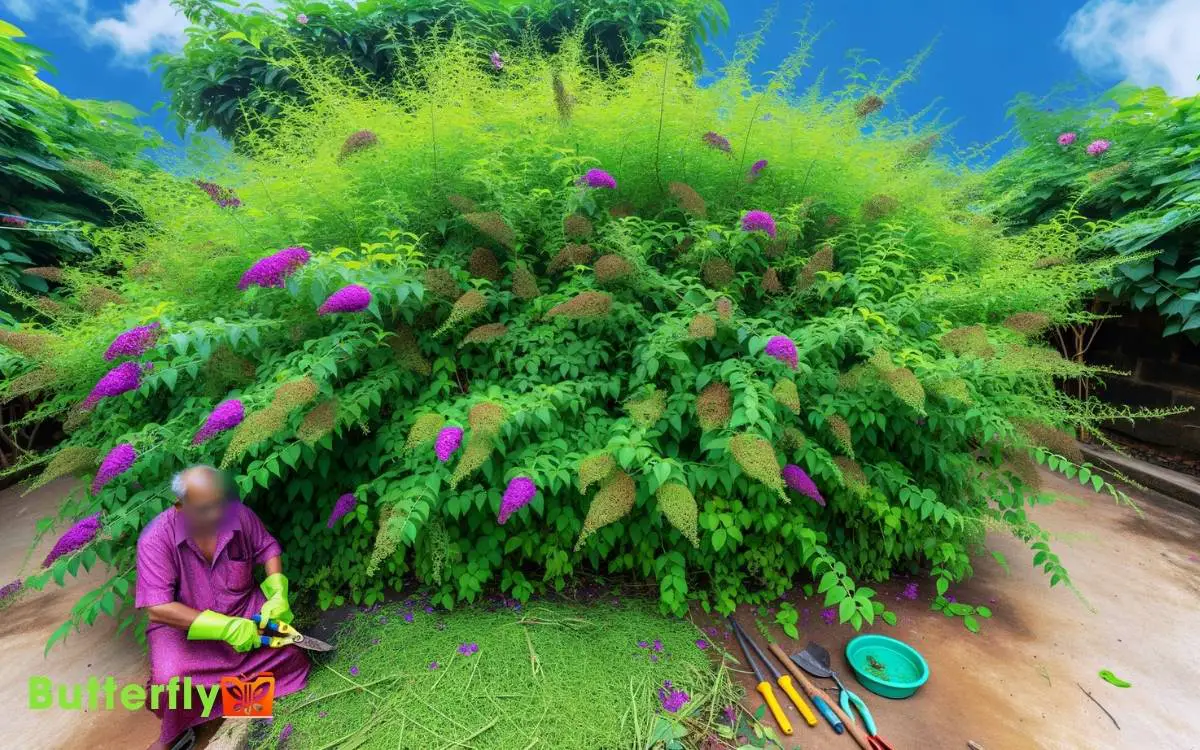How To Make Butterfly Bush Bushier? Tips and Techniques!
To make your butterfly bush bushier, start by planting it in full sun with well-drained soil. Verify pH levels between 6.0-7.5 and amend with compost for fertility. Space plants 4-6 feet apart to promote air circulation.
Implement a consistent watering schedule, deeply watering once a week. Apply a balanced slow-release fertilizer, such as 10-10-10, in early spring and repeat every 6-8 weeks.
Prune in late winter to encourage new growth and improve air flow. Use organic mulch to retain moisture and regulate soil temperature. For detailed seasonal care and propagation techniques, there is more to explore.

Key Takeaways
Choose the Right Location
Selecting the appropriate location for your butterfly bush is crucial because it requires full sun and well-drained soil to flourish. You’ll need to make sure the site receives at least six hours of direct sunlight daily.
Avoid shaded areas as they hinder photosynthesis, reducing growth and bloom production. Evaluate the drainage by observing water absorption post-rainfall;
The soil shouldn’t stay waterlogged for more than a few hours. Positioning your bush in an elevated spot can improve drainage and prevent root rot.
Consider the microclimate; spaces near walls or fences can create heat pockets, enhancing growth. Additionally, establish a buffer zone of 3 to 4 feet around the plant to facilitate air circulation, reducing the risk of fungal diseases.
Soil Preparation
Preparing the soil meticulously is essential to guarantee that your butterfly bush thrives, requiring well-drained, fertile ground rich in organic matter. First, perform a soil test to determine pH levels, ensuring they fall between 6.0 and 7.5, which is ideal for butterfly bushes.
Amend the soil with organic compost or well-rotted manure to enhance nutrient content and improve drainage. Next, incorporate perlite or sand to increase aeration and prevent waterlogging.
Here’s a precise checklist to follow:
- Soil Testing: Measure pH and nutrient levels.
- Organic Amendments: Add compost or manure to enrich soil.
- Aeration Materials: Mix in perlite or sand for better drainage.
Planting Techniques
When planting your butterfly bush, make sure the soil is well-drained and enriched with organic matter for best growth. Choose a location that receives full sun, as this will encourage abundant flowers throughout the growing season. Regular pruning can also help promote new growth and prevent the issue of a butterfly bush not blooming. Additionally, avoid over-fertilizing, as too much nitrogen can lead to excessive foliage at the expense of flowers.
Space each plant about 4 to 6 feet apart to provide ample room for expansion and air circulation.
These steps will promote a healthier, bushier butterfly bush.
Optimal Soil Preparation
Ensuring ideal soil preparation for your butterfly bush involves amending the soil with organic matter to improve drainage and nutrient availability.
You should focus on creating a well-aerated, nutrient-rich environment. Start by testing your soil pH; butterfly bushes thrive in slightly acidic to neutral soil (pH 6.0-7.5).
Follow these steps for best results:
- Incorporate Compost: Mix 2-3 inches of compost into the top 8-10 inches of soil to enhance organic content.
- Add Perlite: Blend perlite at a ratio of 1:4 with soil to improve aeration and prevent waterlogging.
- Apply Slow-Release Fertilizer: Use a balanced, slow-release fertilizer (10-10-10) to provide essential nutrients over time.
Proper Spacing Guidelines
Having prepared the soil perfectly, you should now focus on planting your butterfly bushes with the correct spacing to guarantee healthy growth and ample air circulation.
Position each butterfly bush at least 5-6 feet apart. This spacing guarantees that each plant receives adequate sunlight and reduces the risk of fungal diseases due to poor air circulation.
Dig a hole twice the width of the root ball and of equal depth. Place the plant in the hole, ensuring the root collar is level with the soil surface. Fill the hole with soil, lightly tamping it down to eliminate air pockets.
Water thoroughly to settle the soil. Proper spacing and planting techniques will encourage robust, bushier growth, enhancing your garden’s aesthetic appeal.
Watering Schedule
To maintain a healthy and bushier butterfly bush, establish a consistent watering schedule that guarantees the soil remains evenly moist but not waterlogged. Peak hydration promotes vigorous growth and prevents stress-induced wilting.
Implement these steps to ensure precision:
- Daily Monitoring: Check soil moisture daily using a soil moisture meter. This ensures real-time data on the plant’s hydration status.
- Watering Frequency: Water deeply once a week, ensuring the soil is moist to a depth of 6-8 inches. Increase frequency during periods of drought or extreme heat.
- Irrigation Method: Utilize drip irrigation systems for slow, deep watering. This method optimizes water usage and minimizes evaporation, ensuring the roots receive adequate moisture without oversaturation.
Fertilizing Tips
Regularly applying a balanced, slow-release fertilizer in early spring can greatly enhance the growth and bushiness of your butterfly bush. Choose a 10-10-10 or 14-14-14 NPK ratio to guarantee an even supply of essential nutrients.
Scatter the granules around the base of the plant, approximately 6 inches away from the stem, to prevent root burn. Incorporate the fertilizer into the top inch of soil using a hand rake or trowel.
Water the area thoroughly to activate nutrient release. Repeat this process every 6-8 weeks during the growing season. This method ensures a steady nutrient supply, promoting vigorous growth and denser foliage.
Avoid over-fertilizing as it can lead to excessive leaf growth at the expense of flowers.
Pruning Basics
Pruning your butterfly bush correctly is essential for promoting bushier growth and maintaining the plant’s overall health.
Focus on these key techniques:
- Timing: Prune in late winter or early spring before new growth begins. This guarantees the plant can allocate energy efficiently.
- Cutting Technique: Use sanitized, sharp pruning shears. Trim branches back to a node or bud, cutting at a 45-degree angle to promote water runoff and reduce disease risk.
- Thinning: Remove dead, damaged, or crossing branches to improve airflow and light penetration, which supports robust growth.
Deadheading Flowers
After mastering pruning techniques, you should focus on deadheading spent flowers to encourage continuous blooming and prevent the plant from wasting energy on seed production. Begin by identifying faded or wilting flowers.
Use sharp, sterilized pruning shears to cut just above the nearest set of healthy leaves or lateral buds. This stimulates axillary bud development, promoting denser foliage and additional flowering.
Regular deadheading, ideally performed weekly, guarantees the butterfly bush allocates resources efficiently towards new growth rather than seed formation.
Additionally, monitor for any potential diseases or pests that may affect the cut areas, ensuring prompt removal to maintain plant health.
By meticulously deadheading, you’ll achieve a more vigorous, bushier butterfly bush that maximizes its ornamental potential.
Controlling Pests
To effectively manage pests on your butterfly bush, start by identifying common culprits such as aphids, spider mites, and caterpillars. Once identified, employ targeted biological and chemical controls.
- Biological Control: Introduce natural predators like ladybugs and lacewings to consume aphids and mites.
- Chemical Control: Apply horticultural oils or insecticidal soaps, making sure you follow the manufacturer’s guidelines to avoid phytotoxicity.
- Cultural Practices: Regularly inspect and prune infested areas to disrupt pest life cycles and promote plant health.
Monitoring is essential; use a hand lens to detect early infestations.
Employ Integrated Pest Management (IPM) strategies to minimize chemical usage and enhance ecological balance.
Adjust tactics based on pest population dynamics and environmental conditions to secure sustainable pest control and a bushier butterfly bush.
Disease Management
You need to start by identifying common diseases such as powdery mildew and root rot that affect butterfly bushes. Use fungicides and proper watering techniques as effective treatment methods.
Implement preventative care practices like ensuring good air circulation and avoiding overhead watering to reduce disease risk.
Identifying Common Diseases
Spotting common diseases in your butterfly bush requires a keen eye for symptoms such as leaf discoloration, wilting, and unusual growth patterns. Early identification is essential for managing these issues effectively.
Here are three prevalent diseases you should watch for:
- Powdery Mildew: This fungal disease manifests as a white powdery coating on leaves and stems. It thrives in humid conditions and can stunt plant growth.
- Verticillium Wilt: This soil-borne fungus causes wilting, yellowing, and eventual death of leaves. It often affects the plant asymmetrically, killing one side first.
- Root Rot: Caused by overwatering and poor drainage, root rot results in black, mushy roots and overall plant decline.
Identifying these diseases promptly will help you maintain a healthier, bushier butterfly bush.
Effective Treatment Methods
How can you effectively manage diseases to guarantee your butterfly bush remains vibrant and bushy?
- Start with precise identification. Use a magnifying glass to detect fungal spores or insect vectors.
- Apply fungicides containing myclobutanil or copper oxychloride at the first sign of powdery mildew or root rot.
- For aphids and whiteflies, introduce beneficial insects like ladybugs or lacewings as biological control.
- Ensure proper air circulation by pruning dense foliage, reducing humidity which fosters fungal growth. Sterilize pruning tools with isopropyl alcohol to prevent pathogen transmission.
- Regularly inspect the soil’s pH; a slightly acidic to neutral range (6.0-7.0) inhibits disease proliferation.
Employing these scientifically-backed methods guarantees your butterfly bush maintains its lush, vibrant appearance.
Preventative Care Practices
Implementing preventative care practices is essential in maintaining a healthy, disease-resistant butterfly bush.
Start by ensuring proper sanitation to prevent pathogen buildup. Regularly inspect your butterfly bush for early signs of disease and promptly remove any affected leaves or stems.
Water management is critical; avoid overhead watering to minimize fungal infections.
To enhance disease resistance:
- Soil Health: Use well-draining soil and apply organic compost to boost microbial activity.
- Pruning Techniques: Prune during dormancy to improve air circulation, reducing the risk of fungal pathogens.
- Integrated Pest Management (IPM): Employ beneficial insects and biological controls to minimize pest populations without harming the plant.
Mulching Benefits
Applying mulch around your butterfly bush helps retain soil moisture, regulate temperature, and suppress weed growth.
Choose an organic mulch like wood chips, bark, or compost to provide additional nutrients as it decomposes. Spread a 2-3 inch layer around the base, ensuring not to pile it against the stem to prevent rot.
Mulch acts as an insulator, stabilizing root zone temperatures and protecting the plant from extreme weather fluctuations. Additionally, it minimizes water evaporation, reducing the need for frequent irrigation.
Weed suppression is essential for maintaining peak growth, as weeds compete for nutrients. Regularly replenish the mulch to maintain its effectiveness.
Seasonal Care
To guarantee your butterfly bush thrives year-round, you should focus on pruning timing, consistent watering, and appropriate fertilizing.
Make sure to prune in late winter or early spring to promote new growth, and adjust your watering schedule based on seasonal rainfall.
Additionally, monitor your plant for pests and diseases, applying suitable treatments as needed to maintain its health.
Pruning Timing Tips
Pruning your butterfly bush at the right times, particularly in late winter or early spring, promotes ideal growth and flowering. During these periods, the plant is dormant, which minimizes stress and encourages vigorous new shoots.
Here are three key steps to follow:
- Identify Dead Wood: Remove any dead or damaged branches to prevent disease and improve air circulation.
- Cut Back Hard: Trim the main stems down to 12-24 inches above the ground. This radical cut encourages robust basal growth and an abundance of blooms.
- Shape Strategically: Prune for shape by cutting just above outward-facing buds. This directs growth outward, preventing overcrowding in the center and ensuring a well-structured, bushier plant.
Watering and Fertilizing
After you’ve pruned your butterfly bush, make sure it receives sufficient water and nutrients to support its vigorous growth and flowering.
Water deeply once a week, ensuring soil moisture reaches a depth of 12 inches. Use a soil moisture meter to maintain ideal hydration levels.
During peak growth periods, apply a balanced, slow-release fertilizer (10-10-10 NPK) in early spring and mid-summer. Avoid over-fertilization to prevent excessive foliage growth at the expense of blooms.
Mulch with organic material like compost or bark chips to retain soil moisture and regulate temperature. This also enriches the soil as it decomposes.
Pest and Disease Control
Regularly inspect your butterfly bush for common pests like aphids, spider mites, and whiteflies, as well as diseases such as powdery mildew and root rot. Early detection is crucial for effective pest and disease management.
Use systemic insecticides or organic options like neem oil to combat infestations. Guarantee proper air circulation by spacing plants adequately to prevent fungal diseases.
Follow these steps for top-notch pest and disease control:
- Monitor: Check leaves and stems weekly for signs of pests and diseases.
- Treat: Apply insecticidal soap or horticultural oil when necessary.
- Maintain: Prune dead or infected branches immediately to prevent spread.
Propagation Methods
To propagate Butterfly Bush, you can utilize techniques such as stem cuttings, layering, and seed germination to guarantee genetic consistency and best growth.
For stem cuttings, select a healthy, non-flowering shoot and cut a 6-inch segment. Remove lower leaves, dip the cut end in rooting hormone, and plant in well-draining soil. Maintain high humidity using a plastic cover.
For layering, bend a low-growing branch to the ground, scrape the bark slightly, and bury the wounded section in soil. Secure with a U-shaped pin and water regularly until roots develop.
Seed germination involves stratification. Store seeds in moist sand inside a refrigerator for 4-6 weeks before sowing them in a seed tray. Keep the medium moist and provide bright, indirect light for best germination.
Monitoring Growth
Ensuring healthy propagation techniques is just the beginning; monitoring growth involves regularly checking for pests, diseases, and nutrient deficiencies to maintain a vigorous Butterfly Bush.
You’ll need to meticulously inspect leaves and stems for aphids, spider mites, and fungal infections. Use a balanced fertilizer to correct nutrient imbalances, ensuring ideal growth conditions.
To maintain a robust Butterfly Bush, execute the following:
- Pest Surveillance: Conduct weekly inspections for aphids and spider mites. Utilize insecticidal soap or neem oil for immediate control.
- Disease Management: Identify and remove any infected plant parts promptly. Apply fungicides as a preventative measure.
- Nutrient Monitoring: Test soil periodically for pH and nutrient levels. Amend with appropriate fertilizers to sustain growth.
Conclusion
To wrap up, guaranteeing your butterfly bush thrives involves more than just basic care. By selecting the right location, preparing the soil, and employing proper planting techniques, you set a strong foundation.
Adhering to a consistent watering schedule, fertilizing appropriately, and mulching can greatly enhance growth. Seasonal care and propagation methods further bolster plant health. Monitoring growth regularly ensures timely interventions.
It’s not just about aesthetics; a bushier butterfly bush supports local ecology by attracting pollinators, thereby enhancing biodiversity.






